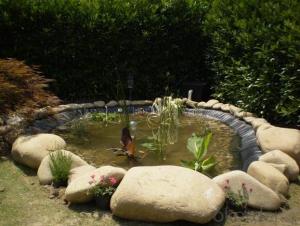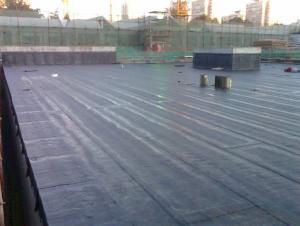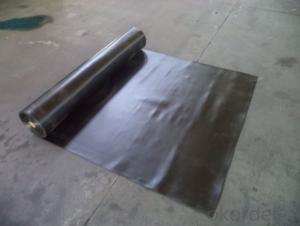EPDM Coiled Waterproof Membrane with 2.0mm Thickness
- Loading Port:
- Shanghai
- Payment Terms:
- TT OR LC
- Min Order Qty:
- 50000 m²
- Supply Capability:
- 5000000 m²/month
OKorder Service Pledge
OKorder Financial Service
You Might Also Like
EPDM Coiled Waterproof Membrane with 2.0mm Thickness
Description Of EPDM Coiled Waterproof Membrane with 2.0mm Thickness:
1. Excellent physical and mechanical performance, high tearing resistance;good deformation adaptability, high puncture resistance;
2. High aging resistance, high UV resistance, anti-acid & alkali;
3. Excellent low & high temperature resistance, innocuous, long life span;
4. Perfect water proof performance, seepage and humidity resistance.
Main Features of EPDM Coiled Waterproof Membrane with 2.0mm Thickness:
A.Polyester based SBS Modified Bitumen Waterproofing Membrane
a. Strong impermeability
b. High tensile strength, elongation, ability to adapt the grassroots shrinkage deformation and cracking
c. Puncture-resistant, broken resistant, tear-resistant
d. The corrosion resistance, resistance to mildew, weathering good
e. Construction convenient, hot-melt can be operated Four Seasons Construction, reliable joints
B. Fiberglass based SBS Modified Bitumen Waterproofing Membrane
a. High tensile strength, stability of a good size
b. High Temperature good performance
c. Damage resistance, corrosion resistance, resistance to mildew, weathering good performance
d. Good construction performance, reliable joints.
Specifications of EPDM Coiled Waterproof Membrane with 2.0mm Thickness:
| Material | EPDM Rubber |
| Size | 1.2m (width)*20m (length) or customized, weldable type 2.05m or 4m width |
| Thick | 1.2mm, 1.5mm, 2.0mm |
| Type | Vulcanized & Weldable |
| Pattern | Non-reinforced (homogeneous) |
| Certificate | ISO9001/14001 |
Applications of EPDM Coiled Waterproof Membrane with 2.0mm Thickness:
geomembrane used in groundsill of road, highway, railway and waterproof layer of swelling clay and wet collapsed loess.Geomembrane can be widely used in areas of garbage burying, waste disposal and underground construction projects.such as below:
- aquaculture ponds
- Ouchi root barrier membrane
- Floating baffles;
- Process wastewater
- Stormwater impoundments;
- Secondary containment;
- Spill containment
- Manure and biogas tanks and covers
- Potable water tanks and covers;
- Sludge Drying beds;
- Bioremediation covers & liners;
- Leachate ponds



IMages of EPDM Coiled Waterproof Membrane with 2.0mm Thickness:




FAQ of EPDM Coiled Waterproof Membrane with 2.0mm Thickness:
1. What are we supplying?
We are specialized in producing Colorful Asphalt Roof Shingle, SBS/APP modified bitumen waterproof membrane, Self adhesive bitumen waterproof membrane, PVC waterproofing membrane, EPDM rubber roofing membrane, Single Component Polyurethane Waterproof Coating, and Spray Polyurea Waterproof Coating
.
2. How Many years experience do we have?
We have been exported to more than 20 countries in the past 15 years.
3. How long do we usually reply your request?
We always reply our customer within 24 hours.
- Q:Can a waterproofing membrane be used for foundation repair?
- Yes, a waterproofing membrane can be used for foundation repair. Waterproofing membranes are commonly used to prevent water intrusion and can be applied to foundation walls to seal any existing cracks or gaps, preventing further damage or leaks. Additionally, they can help improve the overall strength and durability of the foundation, providing long-lasting protection against water damage.
- Q:Can a waterproofing membrane be used in commercial buildings?
- Indeed, it is possible to utilize a waterproofing membrane in commercial establishments. Waterproofing membranes serve the purpose of safeguarding diverse sections of a building, encompassing roofs, foundations, and basements, against water infiltration. In the case of commercial buildings, where the likelihood of water harm is heightened due to larger surface areas, increased foot traffic, and intricate architectural designs, waterproofing membranes prove to be a viable solution. These membranes are specially crafted to establish a protective barrier against water, thereby averting leaks, moisture, and potential structural harm. Furthermore, the integration of waterproofing membranes contributes to the longevity of the building by reducing the risk of deterioration resulting from exposure to water. Consequently, the incorporation of a waterproofing membrane system in commercial establishments aids in maintaining a secure and dry environment, safeguarding valuable assets, and optimizing the lifespan of the structure.
- Q:How does a waterproofing membrane handle water vapor transmission?
- A waterproofing membrane is designed to prevent the passage of liquid water, but it can also handle water vapor transmission. This is achieved through the use of materials and technologies that allow the membrane to be vapor-permeable. Water vapor transmission refers to the movement of water molecules in the form of vapor through a material. In the case of a waterproofing membrane, it is important to ensure that water vapor can escape from the structure to prevent moisture buildup and potential damage. There are different types of waterproofing membranes available, and each may have its own method of handling water vapor transmission. Some membranes are made with microporous materials that have tiny pores or perforations, which allow water vapor to pass through while still preventing liquid water from penetrating. Other membranes may incorporate special coatings or treatments that enhance their vapor transmission properties. These coatings can help regulate the flow of water vapor, allowing it to move through the membrane while still providing an effective barrier against liquid water. Additionally, some advanced waterproofing membranes have built-in moisture management systems that actively control water vapor transmission. These systems can sense and adjust the vapor flow based on the environmental conditions, ensuring optimal moisture control within the structure. It is important to note that the effectiveness of a waterproofing membrane in handling water vapor transmission depends on various factors, such as the type of membrane, its installation, and the specific environmental conditions. Proper installation, including the use of appropriate adhesives and sealants, is crucial to ensure the membrane's vapor transmission capabilities are not compromised. Overall, a waterproofing membrane is designed to handle water vapor transmission by allowing the escape of water vapor while still providing a reliable barrier against liquid water infiltration. By employing various technologies and materials, these membranes help maintain a dry and moisture-free environment within a structure.
- Q:Are waterproofing membranes suitable for wastewater treatment plants?
- Yes, waterproofing membranes are suitable for wastewater treatment plants. Wastewater treatment plants deal with the treatment and processing of wastewater, which contains a variety of chemicals, contaminants, and bacteria. These substances can be highly corrosive and can cause damage to the infrastructure of the plant if not properly protected. Waterproofing membranes provide an effective barrier against water and chemical penetration, preventing leaks, seepage, and corrosion. They can be applied to various areas of the plant, including tanks, basins, pipelines, and concrete structures. Additionally, waterproofing membranes are durable, long-lasting, and can withstand the harsh conditions and chemicals present in wastewater treatment plants. Therefore, using waterproofing membranes in wastewater treatment plants is a recommended practice to ensure the integrity, longevity, and efficiency of the infrastructure.
- Q:Can a waterproofing membrane be used in conjunction with tile or stone installations?
- Certainly! When installing tile or stone, it is highly recommended to utilize a waterproofing membrane. This membrane serves as a barrier, preventing water from seeping into the underlying layers and causing damage. It is especially beneficial in wet areas, such as bathrooms, showers, and kitchen backsplashes. There are different types of waterproofing membranes available, such as liquid-applied, sheet, and fabric membranes. These can be applied to the substrate before installing the tile or stone, creating a waterproof layer that keeps the area dry and free from water-related issues. In addition to safeguarding against water damage, a waterproofing membrane also helps to prevent the growth of mold and mildew, which can be detrimental to both the installation and the health of those using the space. It is essential to note that proper installation of the waterproofing membrane is crucial for its effectiveness. Following the guidelines and best practices provided by the manufacturer ensures a tight seal and complete coverage. Overall, integrating a waterproofing membrane with tile or stone installations is a prudent decision. It enhances the project's durability and longevity while providing peace of mind against potential water damage.
- Q:Does a waterproofing membrane have any impact on the indoor air quality?
- Yes, a waterproofing membrane can have an impact on indoor air quality. It helps prevent water infiltration into the building, reducing the risk of moisture-related issues such as mold and mildew. By keeping moisture out, it helps maintain a healthier indoor environment with improved air quality.
- Q:About asphalt waterproofing membrane
- 4, SBS membrane is commonly referred to as a polymer modified asphalt coil, there are other APP, APAO and other modified asphalt membrane.
- Q:Can a waterproofing membrane be used for swimming pools or water features?
- Swimming pools and water features can benefit from the use of a waterproofing membrane. This membrane is designed to create a barrier that prevents water from causing damage by seeping through. It is commonly used in various applications, such as swimming pools and water features, to keep the water contained within its designated area. When choosing a waterproofing membrane for these purposes, it is important to select one that is specially formulated to withstand the constant exposure to water, chemicals, and other elements commonly found in these environments. Proper installation is crucial to ensure the effectiveness and longevity of the membrane. To determine the most suitable waterproofing membrane for your specific project, it is recommended to seek professional advice.
- Q:Can waterproofing membranes be used on stormwater management systems?
- Indeed, stormwater management systems can benefit from the application of waterproofing membranes. These membranes are frequently utilized to safeguard structures against water infiltration and potential water-related harm. In the case of stormwater management systems, which are designed to collect, retain, and efficiently handle rainwater runoff, waterproofing membranes can be employed to establish a completely watertight seal, thereby averting leaks and seepage. Stormwater management systems often incorporate various components, such as retention ponds, infiltration basins, or underground storage systems. These elements must be adequately sealed to ensure the proper containment and effective management of the collected stormwater. When properly installed, waterproofing membranes serve as an impermeable barrier, effectively preventing water from escaping or infiltrating the system. The utilization of waterproofing membranes on stormwater management systems offers numerous advantages. Firstly, it helps to maintain the system's integrity and functionality by preventing leaks or seepage that could compromise its performance. This ensures that the stormwater is efficiently captured and managed, minimizing the risk of flooding or erosion. Furthermore, waterproofing membranes can significantly prolong the lifespan of stormwater management systems by safeguarding them against water damage. Water infiltration can lead to structural degradation, corrosion, or the proliferation of mold and mildew, all of which weaken the system over time. By establishing a waterproof barrier, these membranes contribute to the preservation of the structural integrity of the components, thus increasing their longevity and reducing maintenance requirements. Moreover, the use of waterproofing membranes on stormwater management systems also contributes to environmental sustainability. By effectively containing and managing stormwater runoff, these systems aid in reducing water pollution and enhancing the quality of natural water bodies. Waterproofing membranes play a vital role in preventing stormwater from carrying pollutants, such as chemicals or sediment, into rivers, lakes, or oceans. In conclusion, waterproofing membranes can be effectively utilized on stormwater management systems to establish a watertight seal, prevent leaks, and protect the components from water damage. By providing an impermeable barrier, these membranes help to maintain the system's functionality and integrity, prolong its lifespan, and contribute to environmental sustainability by reducing water pollution.
- Q:Can a waterproofing membrane be used for tunnels and subway stations?
- Yes, a waterproofing membrane can be used for tunnels and subway stations. Waterproofing membranes are designed to prevent the ingress of water and moisture into structures, making them an ideal solution for underground spaces such as tunnels and subway stations that are prone to water infiltration. These membranes are typically made of high-quality materials such as bitumen or synthetic polymers, which have excellent water-resistant properties. Using a waterproofing membrane in tunnels and subway stations provides several benefits. Firstly, it helps to protect the structural integrity of the underground infrastructure by preventing water from seeping into the concrete or other building materials. This can help to prevent corrosion and degradation of the structure, ensuring its longevity and safety. Secondly, a waterproofing membrane helps to maintain a dry and comfortable environment within the tunnels and subway stations. It prevents water from accumulating, which can lead to the growth of mold, mildew, and other harmful microorganisms. Additionally, it helps to control humidity levels, reducing the risk of condensation and water damage to equipment, electrical systems, and other components. Furthermore, waterproofing membranes can also act as a barrier against the ingress of external contaminants such as pollutants, chemicals, and gases. This is particularly important in subway stations, where there may be a higher concentration of pollutants from train exhaust and other sources. Overall, using a waterproofing membrane in tunnels and subway stations is a crucial step in ensuring the durability, safety, and comfort of these underground structures. It provides an effective solution for preventing water infiltration, protecting the infrastructure, and maintaining a dry and healthy environment for passengers and staff.
1. Manufacturer Overview |
|
|---|---|
| Location | |
| Year Established | |
| Annual Output Value | |
| Main Markets | |
| Company Certifications | |
2. Manufacturer Certificates |
|
|---|---|
| a) Certification Name | |
| Range | |
| Reference | |
| Validity Period | |
3. Manufacturer Capability |
|
|---|---|
| a)Trade Capacity | |
| Nearest Port | |
| Export Percentage | |
| No.of Employees in Trade Department | |
| Language Spoken: | |
| b)Factory Information | |
| Factory Size: | |
| No. of Production Lines | |
| Contract Manufacturing | |
| Product Price Range | |
Send your message to us
EPDM Coiled Waterproof Membrane with 2.0mm Thickness
- Loading Port:
- Shanghai
- Payment Terms:
- TT OR LC
- Min Order Qty:
- 50000 m²
- Supply Capability:
- 5000000 m²/month
OKorder Service Pledge
OKorder Financial Service
Similar products
New products
Hot products
Related keywords































